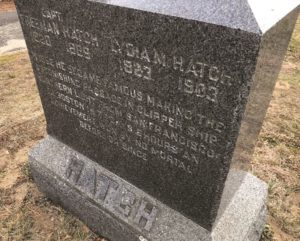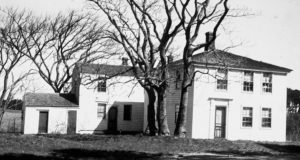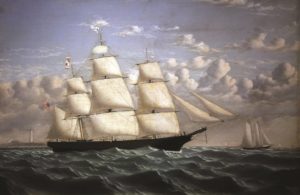In Eastham’s Evergreen Cemetery where, last spring, the courageous service of the keepers of Nauset Beach Light Station was honored with a solemn ceremony, the nephew of keeper Henry Young Hatch (1798-1858) rests in a corner, his epitaph hinting at his own daring adventure.

Capt. Freeman Doane Hatch, born in 1820, was one of nine children of Abigail Mayo and Freeman Doane Hatch, Henry’s brother. He came of age when the demand for the swift delivery of tea from China and provisions for the California Gold Rush spawned a class of graceful, streamlined three-masted merchant vessels known as clippers. As Samuel Eliot Morrison noted in his Maritime History of Massachusetts, only the most experienced seamen could “be trusted to drive these saucy, wild clippers against Cape Horn howlers.”
The 180-foot clipper Northern Light, designed by Samuel Hartt Pook and built by Edward and Henry O. Briggs at their South Boston shipyard, was protected by a carved angel figurehead, draped in white and holding a flaming torch. She was launched on Sept. 21, 1851. For her second voyage to San Francisco via Cape Horn, with Capt. Freeman Hatch at the helm, Northern Light departed Boston on Oct. 28, 1852, and completed the 15,000-mile voyage to the West Coast in 118 days.
Among clipper ship captains, racing around the treacherous Horn with its extreme weather, mountainous seas, and strong currents had become something of a maritime sport, and though Northern Light’s outward passage under Capt. Hatch was completed in a respectable time, her return voyage would be legendary.
Sailing against the clipper Contest, bound for New York, and with bets placed, Northern Light departed San Francisco on March 13, 1853. Driven hard by Hatch, she sailed past Boston Light 76 days, 5 hours later, besting a previous record of 84 days. She docked in Boston Harbor two days ahead of the Contest’s arrival in New York, winning not only the bet but an honored place in maritime history. Captain Hatch’s sailing record still stands for a single hull ship, broken only by a multi-hull vessel in the early 1990s.
By 1854, Northern Light had been sold to Capt. Seth Doane of Orleans, who had served as mate on the record-breaking voyage, and until 1861 he was both owner and captain, making voyages to Calcutta, Manila, and Shanghai. Under new ownership and command, Northern Light made its first transatlantic passage in 1861, tragically meeting her demise in early January 1862 when, returning from Le Havre, she collided with a French brig. Though the crew was spared, the celebrated clipper was so severely damaged that she was abandoned.

Capt. Hatch continued to go to sea until the early 1860s, when he came ashore, left his Eastham homestead — the site at the corner of Samoset and Clark’s Point roads is marked with an engraved stone — and moved with his wife, Lydia, to Needham. He is listed on the 1865 Massachusetts census as a trader.
By 1870, then living in Hyde Park, he declared his occupation to be physician, though not in the conventional sense. In early and mid-19th century America, dissatisfaction with orthodox medicine — blood-letting and toxic mineral purgatives — spawned a system of alternative, non-invasive, natural treatments.
Remedies such as hydrotherapy, as well as the Thomsonian botanical “cures” that were prescribed during Eastham’s 1816 epidemic, grew in popularity, even though they were routinely ridiculed and dismissed as quackery by conventional medical professionals. Homeopathic medicine — the belief that the body can cure itself — was associated with the religious movement known as Spiritualism, and with its use of mediums claiming to possess an invisible energy that could facilitate communication with the departed.
Capt. Freeman Hatch joined the growing ranks of alternative practitioners known as magnetic physicians who employed energy healing, often by way of hypnotism, a therapy promoted by the 18th-century physician Franz Anton Mesmer. He believed that health and well-being were controlled by an invisible natural force, a magnetic fluid coursing through all living things.
Ailments were caused by an interruption or imbalance of the fluid, but health could be restored by revitalizing powers transmitted in the hands of healers with a strong magnetic force. So, too, with a simple wave of the hands, could that invisible energy be used to magnetize medicines, thus ushering in a plethora of patent balms, ointments, and oils that promised an effect similar to that of hands-on therapy.

In time, a variety of blind tests — where patients are unaware of the treatment they are receiving — demonstrated that Mesmer’s magnetism did not exist. These also revealed that beneficial results could be explained by the patient’s own belief in the remedy — a phenomenon we know today as the placebo effect.
Capt. Freeman Hatch — known by some as Dr. Freeman Hatch — lived out his life in Hyde Park, maintaining an office in Boston. After a brief illness, he died in March 1889. His Eastham home, neglected for years, was razed in 2003, but his polished black headstone remains a tangible reminder of his record-setting voyage and of Eastham’s place in the short-lived era of beautiful wooden sailing ships.
Editor’s note: McGuiggan’s story about Thomsonian herbal remedies and Eastham’s typhus epidemic was published here on April 30, 2020.
